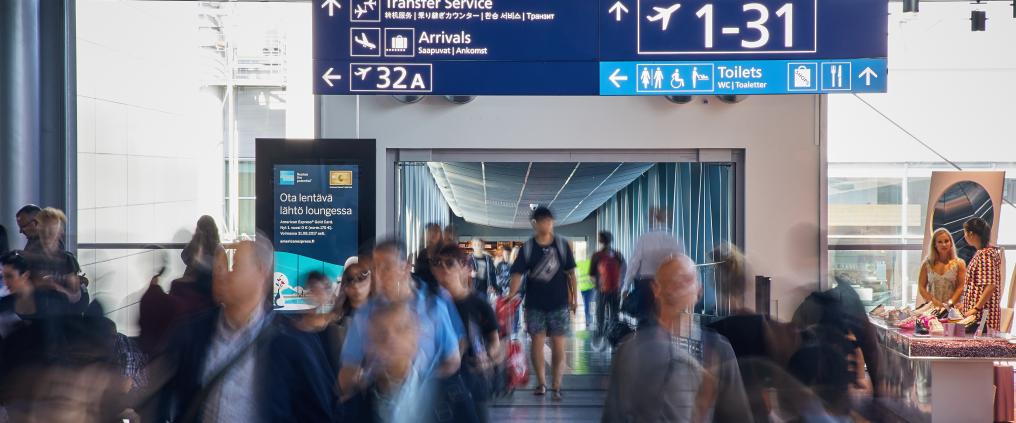How to use the check-in machine? Where’s to find the bathroom or the departure gate? Is the airport busy or noisy? Will I make my flight? Will I get past security? Have I packed things correctly?
For many, air travel is a somewhat stressful experience. For instance, in a survey commissioned by life assistance company CPP, a third of the 2,000 British respondents found the airport experience more stressful than the working week, and quarter thought it even more stressful than moving.
”The most stressful parts are usually at the start of the passenger path: coming to the airport, checking in and the security check. Once passengers get past security, they usually relax,” says Finavia Customer Experience Manager Johanna Laakso. “Our aim is to alleviate stress in any way possible, so that the airport experience is as smooth as possible.”
1. Sense of control – Do I know what to do at the airport?
In large part, airport stress is related to a person’s need to control his or her own environment, says psychologist Annu Haapakangas.
”From the perspective of environmental psychology, humans have a natural need to control their environment. At the airport, however, there are several elements that reduce that sense of control: passenger movement is regulated and they are subject to strict routines and security checks,” Haapakangas says.
For many, the airport is also a foreign environment, which can further reduce their sense of control in the situation.
”Frequent travellers, on the other hand, can create their own routines and favorite spots, which can reduce stress,” Haapakangas says.
Laakso says that one of the cornerstones of customer experience at the airport is boosting passengers’ confidence level and sense of control.
”For instance, we put a lot of effort into making our signs clear and easy to follow, and make sure we have enough staff to help passengers at the check-in machines. We want the passenger to feel confident that they know how to operate at the airport,” Laakso says.
2. Rush – Will I make it?
Another limiting factor on passengers’ sense of control are the strict schedules related to air travel.
”The most important question for passengers is usually ’Will I make it’?,” Laakso says. “Will I make my flight? Will I make it if I get a coffee, go to the bathroom or shop around for a while?”
The airport tries to help in this too, starting from controlling passenger flows in a smart way all the way to tiny nuances of terminal design.
”Something as simple as the placement of timetables and clocks, can be really important. We also offer extra services to help passengers. For instance, starting this fall, Chinese transfer passengers have been able to order a personal assistant to help them navigate the airport during their transfer.”
One of Helsinki Airport’s advantages is that it is compact in size: distances to departure gates are usually short. The airport’s goal is to create a relaxed atmosphere even in the midst of rush hour.
”We talk about the ’gift of time’. Even though schedules are tight, we want passengers to feel like they aren’t rushed for time.”
3. Crowds and noise – How to calm down at the airport?
Moving in large crowds of people can also cause negative or stressful emotions in some passengers.
”So called crowding stress relates to situations in which a person has a lot of strangers in his or her vicinity, which makes it difficult to control personal space and privacy,” Haapakangas says. “This can even cause physiological reactions: a person’s pulse quickens, blood pressure rises, and they may be more prone to experience negative emotions.”
Haapakangas, who has studied especially reactions to noise in work spaces, says that acoustics play a large role in how stressful environments feel.
”Noise is definitely a stress factor, but solutions to noise problems are also available through design and material choices,” Haapakangas says.
At Helsinki Airport, one of the aims of space planning is to create cozy and functional spaces where passengers can feel a sense of calm while travelling.
”We favour quality materials and Finnish design that is both beautiful and functional. We try to offer passengers refreshing experiences and calm spaces for waiting. For instance, one of the gate areas now has a large green wall, which cleans air and creates a sense of a natural environment,” Laakso says.
As Helsinki Airport expands, Laakso hopes both passengers and staff stay patient despite the changing environment.
”The building and renovation work bring a lot of changes to the airport, which may create challenges. I hope we all maintain a sense of calm in the midst of these changes.
Read four tips for stress-free traveling with kids
How to pack for flight and traveler's check-list
